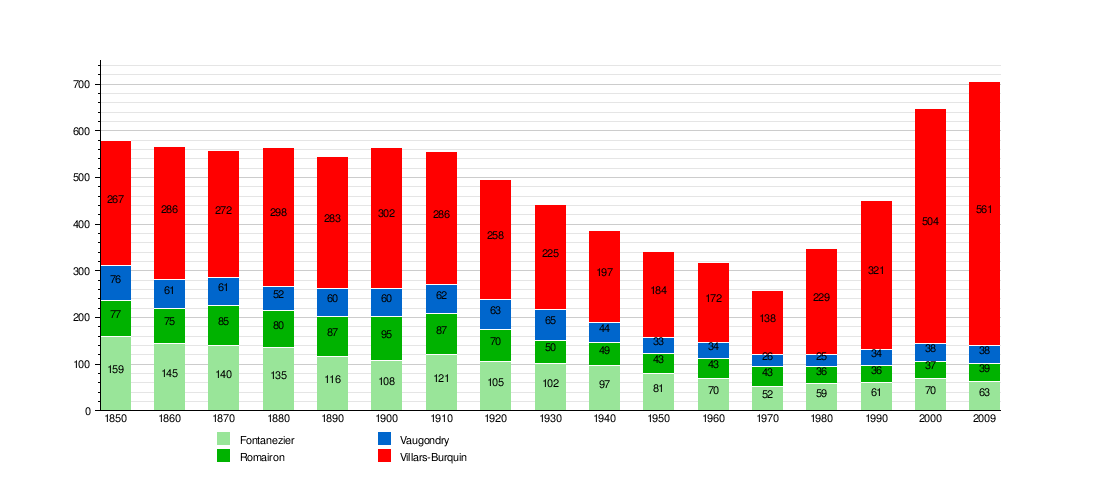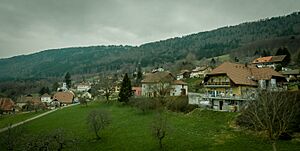Tévenon facts for kids
Quick facts for kids
Tévenon
|
||
|---|---|---|
|
||
| Country | Switzerland | |
| Canton | Vaud | |
| District | Jura-Nord Vaudois | |
| Area | ||
| • Total | 14.28 km2 (5.51 sq mi) | |
| Population
(Dec 2020 )
|
||
| • Total | 894 | |
| • Density | 62.61/km2 (162.15/sq mi) | |
| Postal code |
1423
|
|
| Surrounded by | Fontaines-sur-Grandson, Mauborget | |
Tévenon is a small town, also called a municipality, located in the Jura-Nord Vaudois area of Vaud, a canton in Switzerland. It was formed on July 1, 2011, when four smaller towns – Fontanezier, Romairon, Vaugondry, and Villars-Burquin – joined together to create one new municipality.
Contents
History of Tévenon: How It Was Formed
Before 2011, Tévenon was known as "Pied-de-la-Côte." It was made up of four separate towns: Villars-Burquin, Vaugondry, Romairon, and Fontanezier. Romairon and Fontanezier were first mentioned in old records from the 1400s.
In 1897, a church was built in Villars-Burquin. This helped bring the people from all four towns closer together. Vaugondry and Villars-Burquin used to be parts of bigger areas. Vaugondry separated from a lordship in Grandson, Switzerland in 1730. Villars-Burquin separated from "Métralie de Fiez" in 1844.
In September 2009, the people in all four towns voted on whether to merge. A large majority, 75% of the population, said yes! The merge was officially accepted and happened on July 1, 2011.
One main reason for merging was that each town was very small. It was hard to find enough people who wanted to be involved in local government. It was becoming difficult to run things smoothly. Because the towns had already worked to build connections, many people supported the idea of becoming one larger municipality.
Geography: Where Tévenon Is Located
When the four towns merged in 2011, Tévenon became much larger. Its total area is now 14.26 square kilometers (1426 hectares).
- Villars-Burquin was 4.81 square kilometers (481 ha).
- Vaugondry was 0.84 square kilometers (84 ha).
- Romairon was 4.89 square kilometers (489 ha).
- Fontanezier was 3.72 square kilometers (372 ha).
This total size makes Tévenon the 41st largest municipality in the canton of Vaud. About 53% of Tévenon is covered by forests. It also has many open fields, called prairies. This is because Tévenon is high up in the mountains. Its highest point is 1432 meters (at La Joux Dessus). The lowest point is 550 meters. The average height of Tévenon is 749 meters.
Weather in Tévenon
Even the lowest parts of Tévenon get snow during the coldest months of the year. In spring, the temperatures start to rise. During the summer, Tévenon is usually only 3 to 4 degrees Celsius cooler than the main flat areas of Switzerland.
In 2014, the average yearly temperature in Tévenon was 12°C. In winter, temperatures often stayed at or just below 0°C. Summer temperatures were not very high. In the early summer months, temperatures were just above 0°C, but they reached up to 9°C in the warmest months.
Getting Around Tévenon
Villars-Burquin is located on a main road that connects Grandson, Mauborget, and Sainte-Croix. Vaugondry and Fontanezier can be reached by roads coming from Champagne and Bonvillars. Romairon can be reached by the road that comes from Fontanezier.
Religion in Tévenon
A study done in 2000 showed the religious beliefs of the people who would later form Tévenon. More than half of the population belonged to the Swiss Reformed Church at that time.
"Religions in Tévenon" Roman catholic church (15.3%) Swiss reformed church (55.1%) Orthodox church (0.3%) Islamic (0.8%) Buddhist (0.7%) Other church (6.3%) No church/atheist/agnostic (18.1%) No answer (3.4%)
Population of Tévenon
As of 2009, Tévenon had a total population of 696 people.
- Villars-Burquin had 556 people.
- Vaugondry had 38 people.
- Romairon had 39 people.
- Fontanezier had 63 people.
About 88% of the people living in Tévenon are Swiss citizens. The other 12% are from other countries. Around 15% of everyone living in Tévenon is under 18 years old.
How Tévenon's Population Has Changed Over Time
The chart below shows how the population of the four towns changed over many years before they merged into Tévenon.

Important Sights in Tévenon
The entire small village of Vaugondry is considered a special historical place. It is listed as part of the Inventory of Swiss Heritage Sites. This means it's important to protect its history and buildings.
Economy: How Tévenon Makes Money
Before the towns merged, their financial situations were already quite good. Villars-Burquin was able to build a fire station. Fontanezier spent a lot of money on installing a new system for wastewater from farms. This was a big cost for Fontanezier.
The towns of Vaugondry and Romairon had smaller budgets. They couldn't help much with the cost of the wastewater system.
Before the merge, the tax rate in the three smaller towns was 85%. In Villars-Burquin, the largest town, the tax rate was 77%. When they merged, the lower tax rate of Villars-Burquin became the new rate for all of Tévenon. This shows how important Villars-Burquin's economy was. The tax rate has since been changed to 73%.
Jobs in Tévenon: What People Do
Hover over the bars to see more details about jobs in each town.
- Primary
- Secondary
- Tertiary
The chart shows that most people in Romairon work in the Primary sector. This means they work in farming or with natural resources. Many Romairon residents are farmers who work close to home.
In contrast, most people in Villars-Burquin work in the Tertiary sector. This includes jobs in services, like shops or offices. Many people from Villars-Burquin prefer to work in other cities.
Even though some areas have many farmers, most people in Tévenon do not work in farming. About 77% of the people said they work more than 10 kilometers away from their homes. They choose to live in Tévenon because of its beautiful location.
Education in Tévenon
In Tévenon, about 230 people have finished upper secondary education. This is like finishing high school. Another 97 people have gone on to higher education. This includes universities or special schools for applied sciences, art, music, or teacher training.
During the 2009/2010 school year, there were 78 students in the Tévenon school district. Children in Tévenon, like all children in the canton of Vaud, must go to school for eleven years.
See also
 In Spanish: Tévenon para niños
In Spanish: Tévenon para niños






